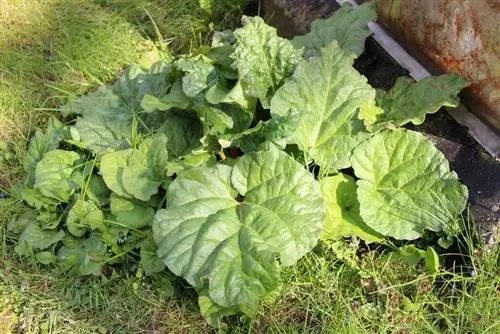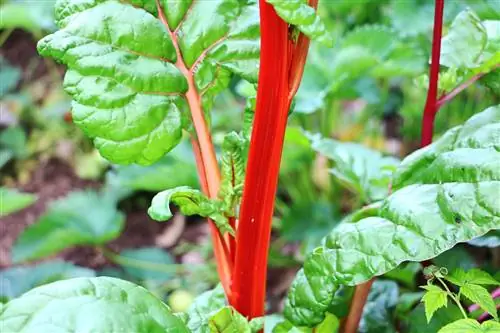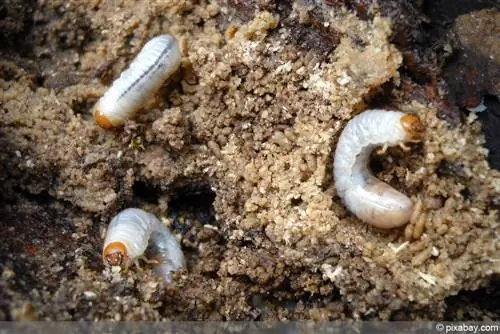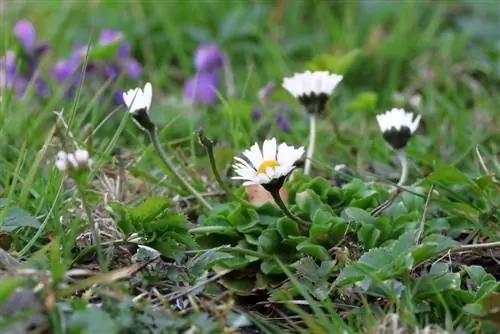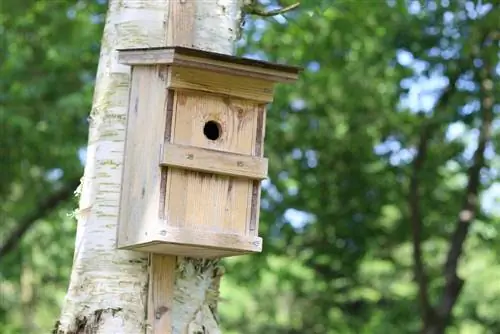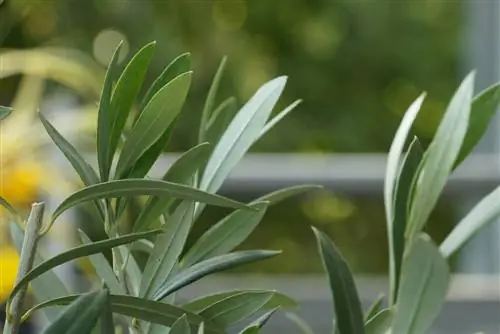- Author admin [email protected].
- Public 2023-12-17 03:39.
- Last modified 2025-01-24 12:45.
Rhubarb (Rheum rhabarbarum) is a perennial plant and is generally considered hardy. Although rhubarb can generally survive the winter without any intervention, there are still some exceptions when it comes to overwintering. Plants that are planted in autumn and those that are grown in pots in particular need some support in the cold season. Find out here how to get rhubarb through the cold season in one piece!
Rest phase and preparation for winter
Preparation for the winter months begins with the last harvest, which takes place at the end of June at the latest. The last possible time for harvesting is June 24th, because that's when the so-called St. John's shoot occurs. This is the second growth spurt in which the rhubarb gathers strength for the winter and the following year. Ideally, the plant will reach the size it was in spring before the cold season.
However, if the rhubarb is harvested until late summer, this weakens the plant enormously and makes overwintering more difficult. In addition, it is not advisable to harvest rhubarb after June, as the oxalic acid content in the plant parts increases over the summer months. This has a calcium-depleting effect, is bad for the joints and promotes rheumatism and the formation of kidney stones. If the rhubarb is still harvested in late summer, the following should be taken into account:
- Rhubarb can still be eaten
- to be on the safe side, the leaf base and stem should be removed
- The oxalic acid can also be largely neutralized
- cook the rhubarb with cream or milk
Cold stimulus is required for growth
Rhubarb is an extremely robust and cold-resistant plant. This is due, on the one hand, to its extremely strong rhizomes and, on the other hand, to its ability to form rhizomes. At the beginning of the cold season, the above-ground parts of the plant die off and the rhubarb puts its energy into the formation of the rhizomes. These are more or less thickened shoot axes that are used to store nutrients.
In order for the rhubarb to bloom again in spring, a cold stimulus (vernalization) is required, in which temperatures are below 10 degrees over a period of around 12 to 16 weeks. The low temperatures are usually not a problem for mature plants in the vegetable patch, whereas plants grown in autumn require additional protection.
Frost protection in the vegetable patch

As a rule:
The plants should be protected in the first winter after planting. The young plants usually did not have enough time to spread sufficient roots in the soil and therefore do not have enough strength to survive the winter months unscathed. It is therefore advisable to take any precautions for winter protection in the fall.
Natural frost protection options have proven particularly useful for rhubarb, such as a layer of leaves or manure. These also have the advantage that they not only protect the plants from frost, but also prepare the soil optimally for spring. The rhubarb is therefore best overwintered in the vegetable patch as follows:
Leaves or brushwood as frost protection
In autumn, many hobby gardeners have to cut back perennials and bushes. However, the cut, thin branches do not have to be thrown away as they are ideal as frost protection for the vegetable patch. For this purpose, the brushwood is simply distributed evenly over the bed. Alternatively, the fallen leaves of trees, which are scattered on the ground above the roots, are also suitable for this purpose. This also has the advantage that it ensures balanced soil moisture and is ideal as a mulching material.
Because the leaves decompose until spring and enrich the soil with valuable humus during the rotting process. The wildlife also enjoys the remaining leaves, as hedgehogs in particular find a sheltered place to overwinter in them. If the leaves are used as frost protection, the following must be observed:
- the leaf layer should not be higher than 5 cm
- otherwise putrefactive processes are promoted
- Weighing down with compost is also advisable
- because this prevents the leaves from being blown away by the wind
Tip:
The leaves of oak, walnut and chestnut rot very slowly. It is therefore advisable to chop it before use.
Stable manure as frost protection
Stable manure is not only suitable as fertilizer, but also serves as a type of heating for the vegetable patch in the winter months. When the manure rots, heat is generated, which protects all plants in the soil from freezing. Horse manure in particular has proven to be a useful heat pack for the bed, but cow or rabbit manure is also suitable for this purpose. When using dry manure as frost protection, please note the following:
- Spread stable manure on the bed
- the layer should be about 10 cm thick
- If necessary, cover the manure with some soil
- the above-ground parts of the plant should not come into contact with the manure
- The remaining rhubarb parts can be easily cut off
Protection in the pot
Although rhubarb plants are mostly grown outdoors, they are also suitable for growing in containers. In contrast to outdoor plants, plants grown in pots must always be protected from frost. Because outdoors, the plant roots are surrounded by the thick garden soil, which serves as natural frost protection. In the pot, however, this protective layer is missing, which is why it is necessary to insulate the containers accordingly.

First, the vessels should be placed on a protective surface, such as a wooden board or a Styrofoam plate. In addition, it is advisable to place the plants in a shady place so that they are not exposed to the strong temperature fluctuations of day and night. The following methods have also proven effective for insulating the containers:
Bubble Wrap
The bubble wrap has small knobs, which is why it is also called bubble wrap. The film is impermeable to air, making it ideal for insulating tubs or pots. For this reason, however, the plants should not be wrapped directly with the film, otherwise the moisture inside cannot escape. When using bubble wrap, please note the following:
- water the plants well before insulating
- Wrap the foil as tightly and as multiple layers as possible around the pot
- the film is UV and weather resistant
- and reusable
Tip:
The bubble wrap can be easily hidden under a jute sack or a jute planter.
Jutesack
Another way to protect the root balls in the pots from frost is to use jute bags. Like bubble wrap, these are simply wrapped around the containers. The decorative aspect of the jute bags is also worth mentioning, as they are available in a wide variety of colors. The jute bags are also characterized by the following aspects:
- water permeable
- air and light permeable
- heat-insulating
- very robust
Tip:
In order to optimally protect the plants from frost, bubble wrap should first be wrapped around the pot as an insulation layer before the jute bag is placed over it.
Coconut mats
Coir mats are an environmentally friendly alternative to protecting the rhubarb from frost. These are a natural product as the mats are made of 100 percent coconut fiber and are therefore biodegradable. The coconut mats also have the advantage of being extremely decorative. These are also simply wrapped around the container and secured with a string if necessary. The coconut mats also have the following positive aspects:
- insulating and heat-insulating
- breathable and moisture-resistant
- dry quickly
- reusable
Conclusion
Rhubarb is generally winter-proof, but young plants and plants cultivated on the balcony in particular should be provided with additional frost protection. In order to optimally prepare the plants for winter, they should be harvested for the last time at the end of June so that they can enter the rest phase and thus gather strength for the winter months and spring.

